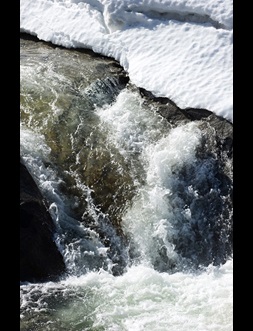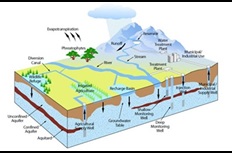Groundwater
Groundwater is an important source of water stored in the earth, deep beneath our feet, in what are called aquifers. Aquifers are the collective saturated spaces between many layers of sands, soils, and gravels (called alluvial aquifers), or the interconnected cracks in bedrock or volcanic deposits (called fractured rock aquifers). Layers of alluvial aquifers make up a groundwater basin. During an average year, California's 515 groundwater basins and subbasins contribute approximately 41 percent toward the State's total water supply. During dry years, groundwater contributes up to 60 percent (or more) of the statewide annual supply and serves as a critical buffer against the impacts of drought and climate change.
 About 83 percent of Californians depend on groundwater for some portion of their water supply and many communities are 100 percent reliant on groundwater for their water needs. DWR’s Sustainable Groundwater Management program manages many aspects of data, assistance, and regulatory processes related to the State’s groundwater management.
About 83 percent of Californians depend on groundwater for some portion of their water supply and many communities are 100 percent reliant on groundwater for their water needs. DWR’s Sustainable Groundwater Management program manages many aspects of data, assistance, and regulatory processes related to the State’s groundwater management.
We mostly access groundwater through wells and pumps, and it is a crucial buffer against drought when surface water supplies in lakes and reservoirs, are running low. When groundwater is extracted in excess of what nature or managed recharge efforts can replenish (called overdraft), groundwater levels drop. Low groundwater levels can cause the ground to gradually sink, a phenomenon known as land subsidence. Subsidence, which is particularly extensive in parts of the Central Valley, puts state and federal aqueducts, flood control structures and other critical infrastructure at risk of damage.
Groundwater Recharge
Groundwater recharge is an important hydrologic process where water moves down (infiltrates) from the ground surface or the bottom of a waterway into an underlying aquifer. Recharge can occur naturally via infiltration of surface water and precipitation through rivers, streams, lakes, wetlands, and open space, or through a more intentional manner by diverting and conveying water to engineered infiltration ponds, spreading basins, flooding of agricultural lands, and injection wells. Aquifers can also be recharged “in-lieu” by not pumping groundwater and using surface water instead of groundwater when it is available.
Depending on a groundwater basin’s subsurface (hydrogeologic) conditions and the time (duration) it takes to infiltrate, groundwater recharge in shallow aquifers can be accomplished in a relatively short amount of time (weeks or months) but recharging deep aquifers can take many years, even centuries.
Sustainable Groundwater Management Act (SGMA)
In order to balance levels of groundwater pumping and recharge, California passed the Sustainable Groundwater Management Act (SGMA). Signed into law by Governor Edmund G. Brown, Jr. in September of 2014, the law requires groundwater-dependent regions to halt overdraft and develop plans to bring basins into balanced levels of pumping and recharge through local planning efforts. SGMA tasked DWR to implement the law and provide ongoing support to local agencies around the State.

Groundwater and surface water are essentially one resource, physically connected by the hydrologic cycle in which water evaporates, forms clouds, and falls to the ground as rain or snow.
Some of this precipitation seeps into the ground and moves slowly into an underground aquifer, eventually becoming groundwater. Water law and water policy often consider groundwater and surface water as separate resources, though they are functionally inter-dependent.
Reports & Resources
- California's Groundwater Live
- State Water Resources Control Board (SWRCB) Groundwater
- US Geological Survey: California Water Science Center
- UC Davis Center for Watershed Sciences
